LABORgLAskAtALOg LABORATORY GLASSWARE CATALOGUE
LABORgLAskAtALOg LABORATORY GLASSWARE CATALOGUE
LABORgLAskAtALOg LABORATORY GLASSWARE CATALOGUE
Erfolgreiche ePaper selbst erstellen
Machen Sie aus Ihren PDF Publikationen ein blätterbares Flipbook mit unserer einzigartigen Google optimierten e-Paper Software.
TECHNICAL INFORMATION | PRODUCT-SPECIFIC SECTION<br />
TECHNICAL INFORMATION | PRODUCT-SPECIFIC SECTION<br />
Care and cleaning of filtration apparatus<br />
In addition to the information in the general section on page 209, please also note the following<br />
guidelines relating to thermal stresses, which apply specifically to filtration apparatus, in order to<br />
avoid glass breakage.<br />
Temperature changes (thermal shock), drying and sterilisation<br />
• The maximum permissible operating temperature is +450 °C.<br />
• Uniform heating is recommended to avoid thermal stresses and resultant breakages.<br />
• Heat glass filtration apparatus with disk diameters of more than 20 mm in initially cold ovens or<br />
sterilisers only.<br />
• The heating or cooling rate should not exceed 8°C/min.<br />
• When filtering hot substances avoid temperatures differences of more than 100 K; if necessary,<br />
preheat the filtration apparatus in a drying cabinet.<br />
• Wet filtration apparatus should be heated slowly up to 80 °C and dried for one hour before<br />
increasing the temperature further.<br />
Whenever possible, filtration apparatus should be stood on its rim (stem upwards) to allow air<br />
convection between the inside of the vessel and the oven chamber. If placing the filtration apparatus<br />
in the oven at an angle cannot be avoided (as in the case of pipeline filters), any support point close<br />
to the position of the filter weld must be protected against heating up prematurely by placing<br />
heat-insulating material under it.<br />
Cleaning new glass filtration apparatus<br />
Before using glass filtration apparatus for the first time, it should be rinsed with water (if applicable,<br />
acid), to remove any minor contamination that may be present.<br />
Mechanical cleaning<br />
In many cases, if no precipitate has infiltrated the pores, simple spraying of the surface (e.g. with a<br />
spray bottle) will suffice. Brushes or rubber wipers can also be used to clean the surface of the filter<br />
disk. If some precipitate has infiltrated into the pores, then back-flushing of the disk is required.<br />
Important instructions:<br />
• Glass filters should always be cleaned immediately after use.<br />
• Do not use sharp objects to remove the filtrate to prevent damage to the filter surface.<br />
Chemical cleaning<br />
If some of the pores on the filter disk still remain clogged after mechanical cleaning or if it is desirable<br />
to make sure that no residue from previous work remains before filtering a new substance, then<br />
thorough chemical cleaning is necessary. The choice of solvent used depends on the nature of the<br />
contamination (see example in the following overview).<br />
Barium sulfate<br />
Silver chloride<br />
Red copper oxide<br />
Mercury residue<br />
Mercury sulfide<br />
Albumen<br />
Grease, oil<br />
Other organic<br />
substances<br />
Screwfilters with interchangeable filter disks<br />
hot conc. sulfuric acid<br />
hot ammonia liquor<br />
hot hydrochloric acid and potassium chlorate<br />
hot conc. nitric acid<br />
hot aqua regia<br />
hot ammonia liquor or hydrochloric acid<br />
acetone, isopropanol<br />
hot conc. sulfuric acid with addition of nitric acid, sodium nitrate or potassium<br />
dichromate<br />
When chemical cleaning is completed, it should be followed by thorough rinsing with copious amounts<br />
of water. Use of hot concentrated phosphoric acid and hot alkali solutions is not recommended, as<br />
these may attack the glass surface.<br />
With 3 filter sizes, each having 4 filter disks of varying porosity, 12 different filter rates are available.<br />
DURAN ® screwfilters have a range of benefits compared with conventional filter apparatus:<br />
• Interchangeable filter disks<br />
• Safe and simple removal of the filtered material<br />
• Disks have longer service life, as no damage is caused by scraping off the fiItered material<br />
• Filter disks are easy to clean from both sides<br />
• Slit sieve (Cat. No. 21 340 31) can be used in the medium sized screwfilter to support<br />
membrane and paper filters<br />
• Space saving<br />
• Cost-effective; filter disks and apparatus can be ordered individually, as required.<br />
Note:<br />
The filter disk should be located between 2 FKM gaskets.<br />
224<br />
225



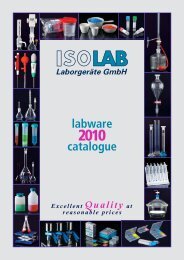
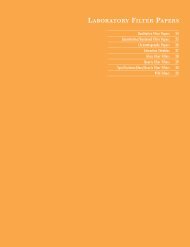
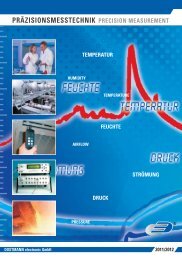
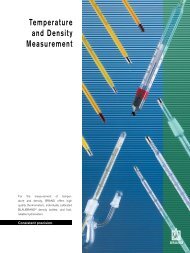
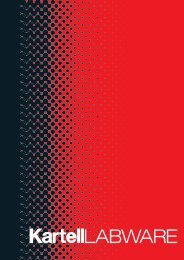

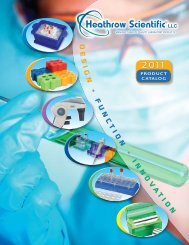


![Download [12.5MB] - Labtek](https://img.yumpu.com/24756492/1/184x260/download-125mb-labtek.jpg?quality=85)
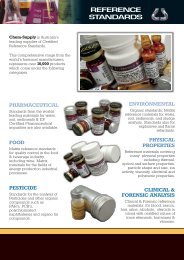
![DYMO Healthcare Brochure [2MB] - Labtek](https://img.yumpu.com/24756484/1/190x240/dymo-healthcare-brochure-2mb-labtek.jpg?quality=85)
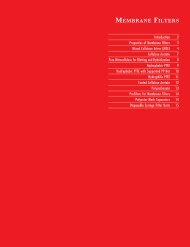
![Download [12.5MB] - Labtek](https://img.yumpu.com/24756470/1/184x260/download-125mb-labtek.jpg?quality=85)